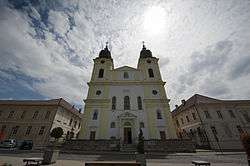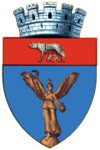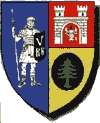Blaj
| Blaj | ||
|---|---|---|
| Municipality | ||
|
| ||
| ||
| Nickname(s): Little Rome | ||
 Blaj Location of Blaj | ||
| Coordinates: 46°10′31″N 23°54′52″E / 46.17528°N 23.91444°ECoordinates: 46°10′31″N 23°54′52″E / 46.17528°N 23.91444°E | ||
| Country |
| |
| County | Alba County | |
| Status | Municipality | |
| Government | ||
| • Mayor | Gheorghe Valentin Rotar (Democratic Liberal Party) | |
| Area | ||
| • Total | 98.93 km2 (38.20 sq mi) | |
| Population (2011) | ||
| • Total | 20,630 | |
| Time zone | EET (UTC+2) | |
| • Summer (DST) | EEST (UTC+3) | |
| Website | http://www.primariablaj.ro/ | |
Blaj (Romanian pronunciation: [blaʒ]; archaically spelled as Blaș; Hungarian: Balázsfalva; German: Blasendorf; Transylvanian Saxon dialect: Blußendref) is a city in Alba County, Transylvania, Romania. It has a population of 20,630 inhabitants.
The landmark of the city is the fact that it was the principal religious and cultural center of the Romanian Greek-Catholic Church in Transylvania.
History
Blaj is first mentioned in 1271 as Villa Herbordi, after the deed of a Count Herbod. In 1313, the domain passed to Herbod's son Blasius Cserei. Started as a hamlet for the twenty families of servants of the noble's court, it was awarded town status on May 19, 1737.
Blaj is the principal religious and cultural center of Greek Catholics in Transylvania. At 27 October 1687 begins the history of the Romanian Church United with Rome, Greek-Catholic, history directly connected to the history of the town Blaj. It all started at the end of the treaty through which Transylvania was entering under the protection of Austria, renouncing the protection of the Turkish Empire.
The first public school in Romanian was established in Blaj in 1754. Blaj was the first place to have Romanian written with Latin alphabet instead of Cyrillic in which it had traditionally been written. Blaj was also a center for the Romanian Age of Enlightenment, being the founding site of the Şcoala Ardeleană society that promoted the Roman cultural heritage of the Romanians. Thus Blaj gained the nickname "The Little Rome".
In 1848, Câmpia Libertății in Blaj was where over 40,000 Romanians met to protest Transylvania becoming a part of Hungary, holding that the lands would be stolen from them.[1]
Geography
Blaj lies at the confluence of the two Târnava Rivers, in a wine-growing region. The city has a continental temperate climate, characteristic for the Transylvanian Plateau, with moderate precipitations of around 550 mm/mp.
Demographics
| Historical population | ||
|---|---|---|
| Year | Pop. | ±% |
| 1930 | 4,618 | — |
| 1948 | 6,641 | +43.8% |
| 1956 | 8,731 | +31.5% |
| 1966 | 15,775 | +80.7% |
| 1977 | 20,826 | +32.0% |
| 1992 | 22,425 | +7.7% |
| 2002 | 21,819 | −2.7% |
| 2011 | 20,630 | −5.4% |
| Source: Census data | ||
Ethnicity
- Romanians - 16,779 (83.78%)
- Hungarians - 1,305 (6.51%)
- Romani - 1,850 (9.23%)
- Germans - 45 (0.22%)
By Religion
- Romanian Orthodox - 14,784 (71.19%)
- Greek-Catholic - 2,732 (13.24%)
- Roman Catholic - 744 (3.58%)
- Reformed Church - 985
- Baptist - 408
- Pentecostal - 220
Government
The city administers eight villages: Deleni-Obârșie (Obursatanya), Flitești, Izvoarele (Csufud), Mănărade (Monora), Petrisat (Magyarpéterfalva), Spătac (Szászpatak), Tiur (Tűr) and Veza (Véza).
Attractions
The castle of the Bethlen dynasty is a popular tourist site near Blaj. Other sights worth visiting include the Metropolitan Palace, the Holy Trinity Cathedral, the "Buna Vestire" Monastery, the Greeks' Church, the "Liberty Field", and Avram Iancu's oak.
Twin towns — Sister cities
Blaj is twinned with:
See also
References
- ↑ Stoica, Vasile (1919). The Roumanian Question: The Roumanians and their Lands. Pittsburgh: Pittsburgh Printing Company. p. 23.
External links
| Wikimedia Commons has media related to Blaj. |


